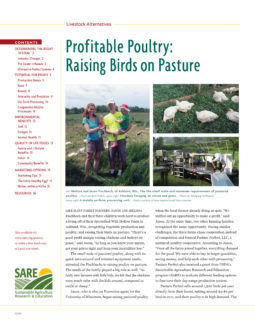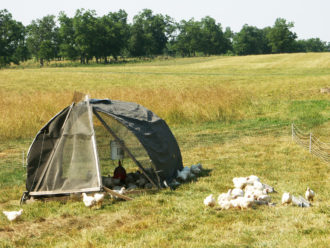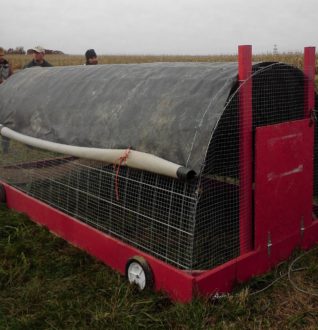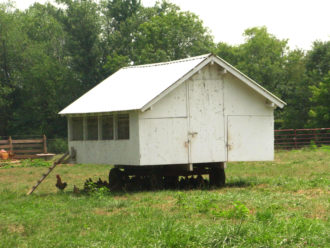Yarding: Keeps birds in stationary housing, but allows them access to yard or pasture during daylight. This model has been a popular way for some confinement poultry producers to tap into the growing market for “free-range” poultry, including the new USDA-certified organic program. They can use the same houses designed for the industrial confinement model, modifying the practice simply by fencing a yard or pasture surrounding the house and allowing flocks to range on it. Without taking care to subdivide the area into paddocks, however, farmers using this method risk concentrating birds, which can denude the soil, deplete nutritious forages and concentrate pathogens. Again, because birds are not contained in pens, they are more open to predation, at least during daylight hours.
The comparative value of the various poultry systems depends on the vision you have for your operation. Seek experienced advice and make use of the wealth of information listed in Resources.
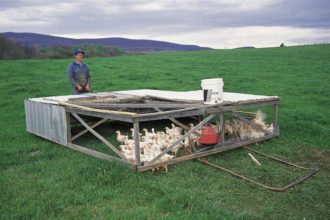 | Pastured Poultry Pen: Encloses birds in floorless portable pens that are moved daily to fresh pasture. Birds feed on grass or other forages, worms and insects, and supplemental grain-based feed. They work their manure into the soil by scratching. Photo: Virginia's Joel Salatin, a leader in the movement to expand poultry production outdoors, demonstrates a movable pen, one of many effective systems for raising poultry on pasture. Photo by Tom Gettings, Rodale Institute |
| “Net” Range (or “Day Range”): Contains birds in movable housing, with electric poultry netting defining a series of paddocks surrounding the house (often a hoop-like structure). Producers move flocks through paddocks, shifting them as the condition of the pasture dictates. With access to the shelter for feeding, rest and shade, birds can escape from both predators and inclement weather. Birds feed on grass or other forages such as vegetable or grain crops, worms and insects, and supplemental grain-based feed. Birds remain vulnerable to predation—especially avian predation—but may be better protected from the more common nocturnal predation because the housing units are usually more resistant than field pens to raccoons, foxes and skunks. Photo: This portable shelter is used in combination with electric fencing on the Elmwood Stock Farm in Georgetown, Ky. Birds are provided supplemental feed and water, and get some degree of protection against the elements and predators. Photo by Jerry DeWitt | |
| “Chicken Tractor”: Contains poultry in small pens to help prepare the soil for garden plots. Birds feed on weeds, garden plants, insects and grubs, and supplemental grain-based feed—while “tilling” and “fertilizing” the soil. Andy Lee, a Virginia farmer and researcher, wrote a book about this system, claiming the birds can do wonders in weed suppression and soil revitalization. Photo: This chicken tractor, at the Dickinson College Farm in Boiling Springs, Pa., is designed to be easily moved across pastures and vegetable beds. The adjustable tarp provides protection from both rain and the hot sun. Photo by Dena Leibman, SARE Outreach | |
| Free Range: Allows birds to range freely across pastures, gardens, and/or cropland, and to return at night or in inclement weather to portable housing. Skids or “eggmobiles” are moved regularly to encourage grazing of particular areas. Birds are vulnerable to predation. Photo: Kent Ozkum and Will Morrow of Whitmore Farm in Emmitsburg, Md., use this chicken coop and others to house heritage breed poultry and move flocks to new pasture as needed. Photo by Dena Leibman, SARE Outreach |
